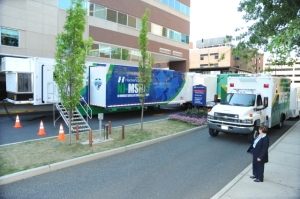by
Lisa Chamoff, Contributing Reporter | February 12, 2014

Hackensack University Medical
Center Mobile Satellite
Emergency Department exterior
From the January/February 2014 issue of HealthCare Business News magazine
Just minutes after a pair of homemade bombs exploded near the finish line of the Boston Marathon last April, the first victims began arriving at the emergency department of Beth Israel Deaconess Medical Center.
Two dozen patients eventually filled the trauma bay and lined the hallways of the facility, a teaching hospital of Harvard Medical School located a little more than two miles from the site of the blasts that left three people dead and injured more than 200 others.
The injuries were difficult for doctors to assess at a glance. Shrapnel, mostly BB-like pellets and nails, had mangled limbs and lodged into people’s chests, near vital organs. Despite the challenges, the first victims were transported to operating rooms within 45 minutes of arrival with the help of Superman and Batman.




Ad Statistics
Times Displayed: 45002
Times Visited: 1379 Keep biomedical devices ready to go, so care teams can be ready to care for patients. GE HealthCare’s ReadySee™ helps overcome frustrations due to lack of network and device visibility, manual troubleshooting, and downtime.
No, these were not superheroes, but the names given to two of the four digital mobile X-ray systems that technicians wheeled right up to patients in the emergency department. The portable DR technology certainly proved its mettle in the critical moments after the terrorist attack.
“The technology really saved a lot of time that could’ve meant lives because they were bringing people into the OR as soon as they could,” says Elisabeth Grady, general diagnostic manager of the radiology department at BIDMC. “The timing was crucial.”
BIDMC uses Carestream’s DRX-Revolution, which came to the market in late 2011. Four of those units were deployed to the emergency department that spring afternoon, along with four older portable X-ray units retrofitted with DR technology. With access to a preview seconds after exposure, physicians could make immediate decisions about how the patients should be treated. They could either immediately order a view of another part of the body, or a technologist could quickly move on to the next patient. For the most part, doctors and technologists were looking at the displays, before the images were sent wirelessly to radiologists for review on a PACS diagnostic workstation.
“They could get a very quick look at what they were dealing with right on the unit,” Grady says.
Simultaneous viewing of images by bedside physicians, using the console, and radiologists at PACS workstations, allows for real-time consultations, says Helen Titus, Carestream’s marketing director of X-ray solutions.
“This can dramatically improve care for seriously injured patients,” Titus says.
The DR technology made it easier to keep the images attached to the correct patient, even when they came into the hospital without identification. While everyone was double-checking patient IDs on exam orders, the portable digital systems also allowed the techs to edit the exam information, if it needed to be corrected, before sending the images to radiologists.

